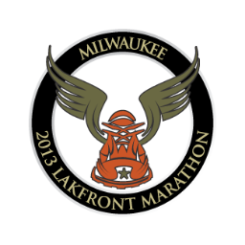I’d like to think I learn something from every race I run. The big ones in particular. When you’ve spent three plus months with your eyes on a specific goal, it’s nice to feel like you have a few takeaways.

I ran the Milwaukee Lakefront Marathon about a month ago – my fifth marathon if you count the Glacial Trail 50k – and maybe more than any race that I’ve run or training cycle that I’ve gone through, I walked away with a few long-held running beliefs tested.
En route to hitting a long sought-after PR and goal of sub 2:40 (I ran a 2:38:57 for 9th place), here are a few lessons learned:
- Mileage Isn’t Everything: If you read LetsRun.com, you’re led to believe that running under 70 miles a week during marathon training is pure “hobby jogger” stuff, definitely not enough distance to post serious times. I followed this logic for several years, churning out 100-mile weeks and averaging 80-85 miles a week during the 12+ weeks of marathon training. Sometimes it worked, other times I was fried, miserable and over trained. This cycle, I just didn’t have that sort of time. I averaged about 68 miles a week, not too far off my standard weekly mileage, and I’ve set PR’s at almost every distance this year. Having a base of big miles no doubt contributed to my current fitness, but I’m more convinced than ever that quality and legs with less wear and tear can trump quantity.
- If You Have to Go, Just Go: I have a weak stomach. Always have. That being said, in the many, many races I’ve run, I have yet to make a pit stop. At mile 4 in the Lakefront Marathon, I noticed a problem was brewing. I was running well, churning out 6:00/min miles, but growing GI unease was becoming an issue. It was uncomfortable and all I could think about. Do I sacrifice time and hop into a port a potty? Do I run through it? About mile 13, I chose comfort over time. I ran a fast mile into the rest stop, gave up maybe 30 seconds, and hit the half marathon point like a 100 pound weight had been lifted from my shoulders. My next mile was quick, and I was completely reenergized. The marathon is long enough for you to recoup time you’ve lost. If something is bothering you: an untied shoelace, your stomach, chafing, etc…addressing it early will save you discomfort and time in the end.
- Tempo all the Time: What do you need to do well in a marathon? Tempo and marathon paced runs. My training this cycle typically consisted of 2 workouts a week and a long run. I did 10-mile stretches of marathon pace during long runs, 7 mile marathon pace runs at lunch, and long cruise intervals ranging from marathon to half marathon pace. I actually bombed a few mile repeat sessions that I had nailed in previous marathon training cycles, and decided to double down on longer, kinda-sorta fast stuff. And you know? It worked. I doubt I’ll set a 5k PR right now, but my body won’t freak out when confronted with long stretches of mild discomfort.
- Don’t Stress The Taper: With my current mileage, I’ve found a two-week taper is plenty. Unless you’re running 100 mile weeks, I think most bodies can recover well by cutting mileage to 70% that first taper week, and 30% the week of the race. However! That doesn’t mean you’re going to automatically feel great the Wednesday before the marathon. My daughter was born five weeks early and VERY unexpectedly the week of the race. My plan for seven days of relaxation and pleasant pasta dinners was replaced with five nights of limited sleep, high levels of stress and general exhaustion. As she slept Wednesday, I snuck away for a quick 5 miles with 3 at marathon pace. It’s a standard pre-marathon confidence builder workout for me. I came back drenched with sweat and pretty certain that I was in for a rude awakening Sunday morning. Luckily, one bad mini-workout – even the week of the race – cannot discredit three months of 20-mile runs and 8-mile tempos. I shook it off, got some decent rest the two nights prior to the race, and focused my energy on what I had already seen my body do: crank out marathon pace runs
- Workouts by Yourself are Hard and Boring. Race Sometimes: It’s difficult to muster the energy for a 10 mile marathon pace run by yourself on a hot August day. But we know it’s really what makes us better runners. Most training will probably be you alone on a road, but incorporating a few smart races during your build up can be an amazing fitness and confidence booster. I firmly believe that long (8-13 mile), marathon paced runs are the key to hitting your time goals. These runs are also taxing to do solo. Jumping into an organized half marathon makes actually doing the workout much, much easier. I ran four races to test and bolster my fitness this cycle, the most productive being the Strider Half Marathon, which I ran AT marathon pace, no faster. Getting 13 miles at marathon pace will make you a stronger runner, and it’s a heck of a lot more fun than running by yourself.
This is really the first marathon I’ve run where things went pretty much as I had hoped. I came through the first half in 1:19:11, and ran the second half in 1:19:46. I was in 15th at mile seven, 14th at the half, and wasn’t passed the final 13 miles to finish 9th overall. I finished feeling truly happy, and really, what more can you ask for?

I bet that had to be a beautiful run!